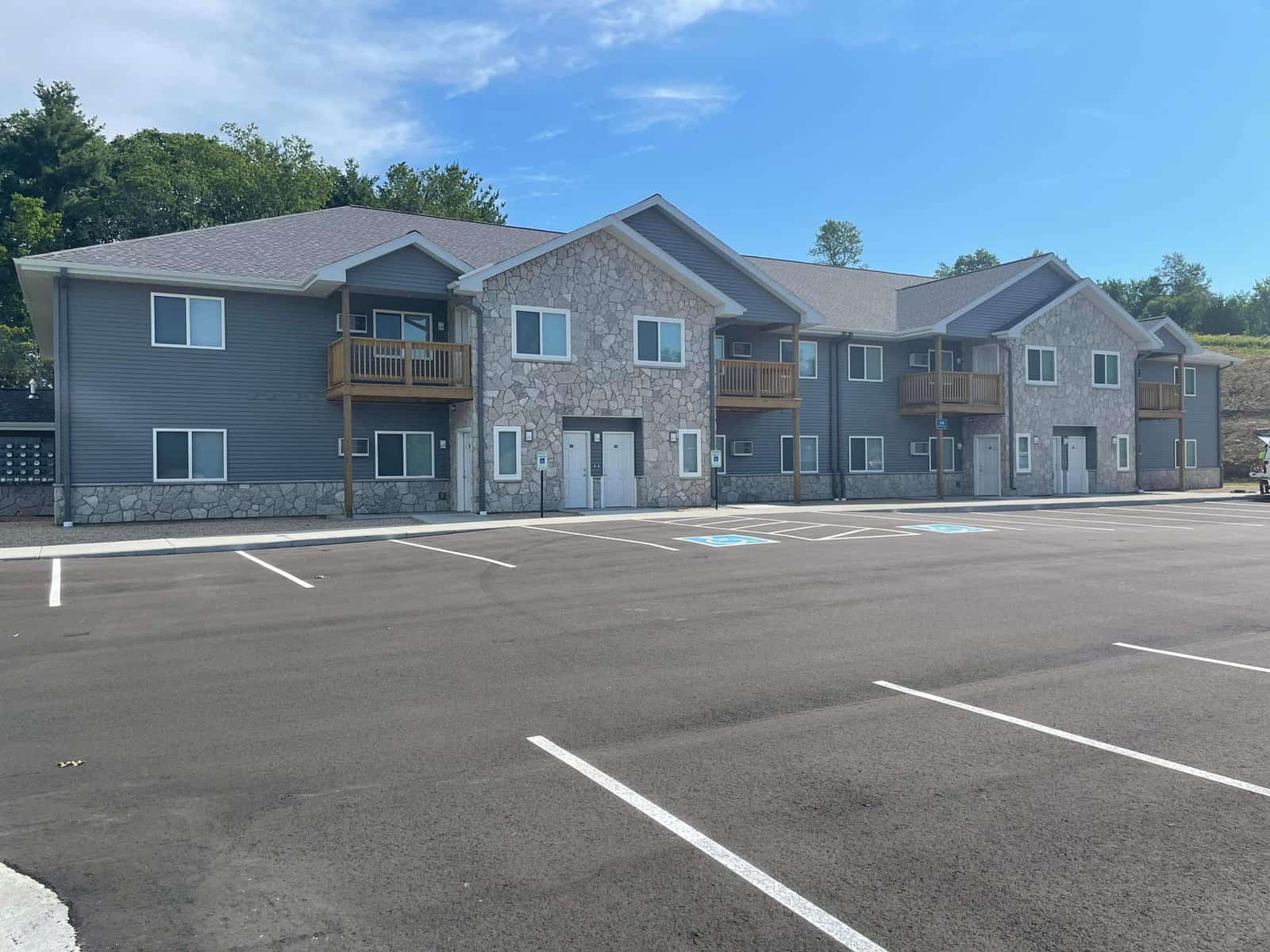Crooked Rivers Apartments Project of Distinction
2022
Cyrus D. Turner and his brother, Hartwell, laid out the Village of Viola in the summer of 1855. Hartwell suggested the name in honor of Viola Buck, who was the Turner boys’ teacher in New York State. The small, picturesque village is located on the Kickapoo River Floodplain with a total area of 1.02 square miles. It is part of the “Driftless Area” because the glacier circumvented this region, leaving behind timber-covered hills and lush, green fertile valleys filled with trout streams and scenic farmland. With a 2020 population of 632, residents are located in both Richland and Vernon Counties. Over the last decade, the population has decreased by 9.59%.
Over the last 14 years, the village has flooded seven times, with the worst flood damage in 2018 after a 15-inch rainfall. Frequent flooding has affected the infrastructure, residences, and businesses. This small community rallied together and began to develop a plan to mitigate future flood damage. Senator Tammy Baldwin, along with the US Department of Agriculture Rural Development (USDA), awarded a Community Facilities Disaster Grant to relocate streets and utilities outside of the floodplain to provide clean water to homes and prevent sewer backups in hopes of spurring future growth in Viola. The grant also included $1 million in leveraged funds through the Department of Housing and Urban Development (HUD) Community Development Block Grant (CDBG) to assist in the re-allocation strategy to move residential and commercial development into proposed resettlement sites. In addition, the USDA worked through their Community Facilities & Environmental programs with village officials to maximize the community’s infrastructure needs by collaborating with other state and federal agencies.
Viola’s planning, zoning, and administrative leaders discovered ways to find productive ways of living, such as flood-proof and elevated housing and organic agriculture, to help their community thrive. As part of the Community Facilities Loan and Grant Program, the village of Viola solicited Holtz Builders Inc., based on our expertise and knowledge, to construct (2) new 16-unit apartment complexes.
These two-story, multi-family apartment buildings were constructed on approximately 3.0 acres. Each building is 16,720 square feet, consisting of eight two-bedroom and eight one-bedroom apartments. Each unit has its own private entry, in-floor heat, and patio or deck area. Since funding for this project came in part through federal grants, it required specific guidelines. One of these included broadband infrastructure – high-speed internet accessible in each unit. Another stipulation required weekly U.S. Department of Labor payroll forms from every subcontractor to the CDBG grant administrator to ensure compliance of the prevailing wages for Vernon County. Equally challenging, this grant restricted overtime hours on the job site, making scheduling more difficult if scopes fell behind. In addition, there was another development near the base of the hillside that was being constructed concurrently. This required additional weekly meetings with the other contractor to coordinate scheduling, logistics, and hooking up the water main.
Using an integrated design, the architect, mechanical and structural engineer, and the construction team worked collaboratively throughout the design and construction phases to provide more comfortable, energy efficient, eco-friendly, and sustainable buildings. Energy standards were met though the installation of energy star appliances, boilers with 95% high efficiency units with indirect water heaters, R-21 insulated walls, R-50 insulated attics, in-floor heat supplied by gas powered boilers, and Cat-6 wiring for broadband infrastructure for all units.
Because the gradient of the slope was so steep, the excavation company used a cut and fill approach to procure a level building pad. By doing so, it exposed some natural springs. Building 2 had exorbitant amounts of water in the soil. The discovery of a spring near the northwest corner of the building forced adjustments to our schedule to start with Building 1 first. After a soil-boring test was completed, we were able to use the native shale soil for fill and compact, which reduced the cost. The excavation crew worked extremely long hours into the nights and weekends to meet the schedule. After extensive grading, filling, and compaction, the solution to direct the spring flowage entailed using clean stone to create a French drain that daylights water underneath the parking lot and into the storm water retention pond.
Building 1 also had an exposed spring coming out of the side of the hill that was continually flowing. Due to the grading of the site, it flowed around the swale of the building. However, it had so much water flowing out (sometimes at rates of more than five gallons per minute), that the swale was incapable of redirecting that much water. Consequently, an engineered French drain diverted the water in the swale to the storm pipes to remediate the overflow. However, since the storm sewer was not connected until the end of the project, problems persisted with the buildup of ice during the cold winter months to where the ice almost breached the sidewalk. The excavation company jackhammered the ice on occasion and scraped the hillside to prevent further erosion.
Viola is a resilient, small, rural village in southwestern Wisconsin that worked with the State and Federal Government after frequent floods damaged their community to catalyze a plan to relocate housing and businesses in hopes of spurring future growth. The site conditions and natural springs posed problems that required cooperation from the civil engineer and site work contractor. Holtz Builders was so appreciative and honored to help maximize the community’s re-allocation strategy by constructing additional housing into their new development.


